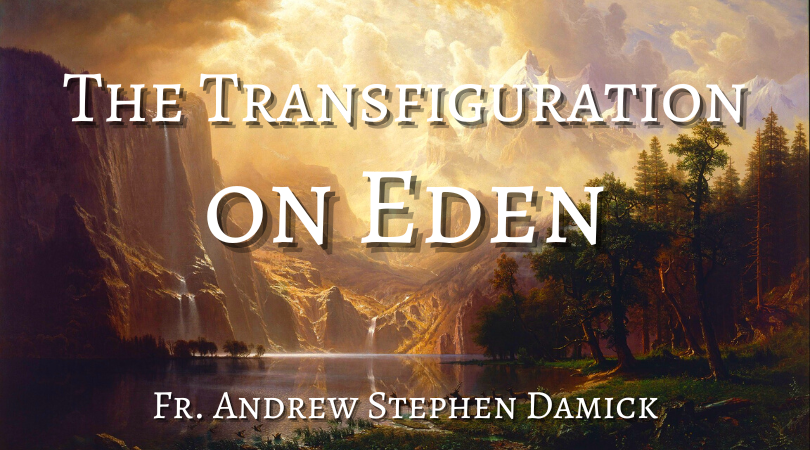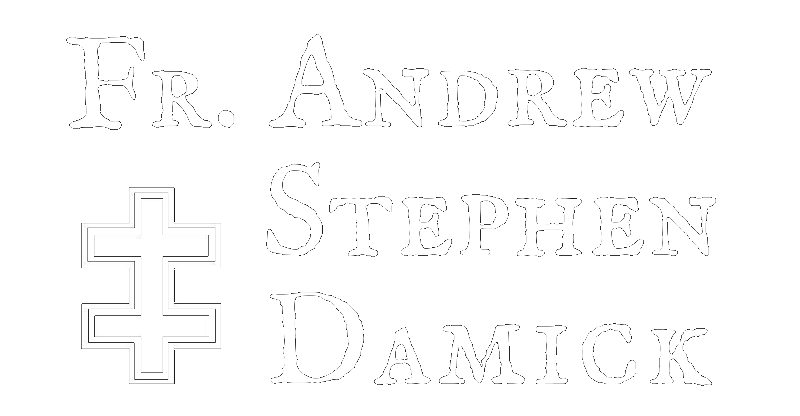
Holy Transfiguration of Christ, August 6, 2023
II Peter 1:10-19; Matthew 17:1-9
In the Name of the Father and of the Son and of the Holy Spirit, one God. Amen.
Today we behold the restoration of Eden. Today we see the door of Paradise standing open, and we gaze within, seeing there the Kingdom of God. Today we behold the Transfiguration of Jesus Christ.
In the events of this feast, as the Gospel says, “Jesus took with Him Peter and James and John his brother, and led them up a high mountain apart” (Matt. 17:1). We should always pay attention when we see Jesus on a mountain or when there is a mountain anywhere in the Scriptures, because it will almost always tell us something about the Paradise of Eden that God created in Genesis.
Now, you may say – wait a minute, is Eden a mountain? If you read Genesis 2, which depicts the creation of Eden, it may not be obvious that Eden is a mountain. We are given a clue, and that is that there are four rivers flowing out of it (Gen. 2:10-14), which means that it has to be at least an elevated place.
But all ambiguity about this is removed when we come to Ezekiel 28, which depicts the casting out of the devil, saying that he had been “in Eden, the garden of God” (Ez. 28:13) and that he had been placed on “the mountain of God” and then was cast down “from the mountain of God” (Ez. 28:14, 16). It is clear, therefore, that Eden is a garden on a mountain – made by God.
So what is Eden, then? It is the place God made for Him to dwell with His people. And as we see with the casting out of Adam and Eve in Genesis 3 and also of the devil in the same chapter (which is a story retold in several places in the Scriptures), when there is sin, the person who has become corrupted by it must leave the presence of God. To remain would be destructive to them, which we see in many places in Scripture – to enter into God’s presence in an impure state is to invite destruction as the burning fire of God’s presence consumes what is sinful.
So let us return now to Tabor, to that “high mountain apart” where Jesus brought Peter, James and John. He stands before them, and, as the Scripture says, “He was transfigured before them, and His face shone like the sun, and His garments became white as light” (Matt. 17:2). What is happening? The Greek word used for transfigured here is metamorphosis, which as adopted into English means “to change from one thing into another.” But that is not really what the Greek word itself means (though it can be used that way).
In Greek, the word simply means “a change in visible form.” It is a little ambiguous even in Greek, however, for, as St. Theophylact of Ohrid says in his commentary on this verse, “When you hear ‘He was transfigured,’ do not think that He had cast off His body at that moment, for His body remained in its own form, as you hear mention of His face and clothing. But it appeared more resplendent, the divine exhibiting in small part its effulgence as much as they were able to see.”
So we should not think that this metamorphosis in Greek, or transfiguration in English, means that Christ changed into something else, that He stopped being human, etc. Rather, what the three disciples could see changed. They could now see, radiating from His human body and human clothes, the uncreated light of God Himself. It is clear in this moment that Jesus Christ is fully God and fully man.
Then, as the disciples were stunned by what they saw, they also saw the Prophets Moses and Elias with Him and speaking with Him (17:3), and a glorious bright cloud descends, from which is heard the voice of the Father, “This is My beloved Son, with Whom I am well pleased; hear Him” (17:5).
Why Moses and Elias? There are at least two reasons. For one thing, both these prophets in the Old Testament spoke with God on mountains.
We can recall how Moses, when He spoke with God on Sinai, also was transfigured, and his face shone so bright that when he came down from the mountain, he had to put a veil over his face so that the people of Israel would not be blinded (Ex. 34:29-35).
Elias also spoke with God on a mountain called Horeb, where God passed by and there was a mighty wind, earthquake, and fire, but then he heard the divine voice only in a gentle breeze (1 Kings 19:11-18). In both these incidents, in a certain way Eden is restored, for these mountains become Paradise while God speaks with these prophets, interacting with them directly and dwelling with them for a while.
The second reason I want to mention about why Moses and Elias are on Tabor with Christ is that both these prophets are also with God in a way different from most of the other righteous dead. There is a tradition that Moses, in addition to having his soul resurrected has also already had his body resurrected by God. This tradition is alluded to in Jude 9, which mentions the Archangel Michael fighting against the devil to retrieve the body of Moses.
And we can recall how Elias is taken up bodily as it were into heaven in the fiery chariot, not quite an ascension like Christ’s but nonetheless a bodily translation to the heavens (2 Kings 2:11).
Here we see two saints participating in the resurrection. How can this be, since Jesus has not even died yet, has not yet entered into Hades to harrow it and bright out the righteous dead? We marvel at this mystery, because what is entered into eternity becomes in a way eternally present, both past and future and actually beyond this linear time that we know.
That is why Christ, even though He is crucified at a certain moment in history, is also the Lamb slain from the foundation of the world (Rev. 13:8). It is also why, even though Christ is incarnate at a certain moment in history, He can walk bodily in Eden and eat with Abraham. His incarnation, death, and resurrection are always present even while they manifest in human experience at certain moments in history.
All of these layers together tell us what is happening on Mount Tabor at the Transfiguration of Christ. St. Theophylact mentions that the glory apparent at the Transfiguration is why Jesus had spoken in the previous chapter about some seeing the coming of the Kingdom of God, and He even says that this vision is related to His second advent – which for us is still in the “future”!
So here we see the Kingdom of God manifest on Tabor. It is God dwelling with His people, Christ presiding among the holy ones. From Him, they receive resurrection and transfiguration – the very glory of God. It is the renewal of Eden, the Mountain of God.
And here is what all this has to do with us: When you come here to this holy place to pray, when you celebrate the feasts, when you go on a pilgrimage to sacred places to venerate what has been sanctified to God, and even when you walk across the room to stand before your icons to come face to face with God – all these moments are also the renewal of Eden.
Our world today does not like the idea that we are not okay as we are. They might even say “God loves you just as you are,” and by that they often mean that God loves us even in our sinful state. And that is true – He loves us no matter what. But if we say “God loves you as you are” and we mean “So you do not have to change,” then we do not understand the love of God.
God does love us as we are, but He loves us so much that He will not leave us as we are. God seeks our resurrection and transfiguration. He loves us with such power that He will not leave us in our sins. And that is why the most basic preaching of the Gospel, not just from St. John the Baptist but also from Jesus Himself is, “Repent, for the Kingdom of God is at hand.”
Today, we have seen the Kingdom of God – it is the glory of Christ shared with His saints, dwelling together in resurrection on the holy mountain of God. And we are called to that glory. And if we will repent, then we will climb the mountain and behold Him face to face.
To the God Who is light, life, resurrection and glory, the Father, Son and Holy Spirit, be all glory, honor and power unto the ages of ages. Amen.



